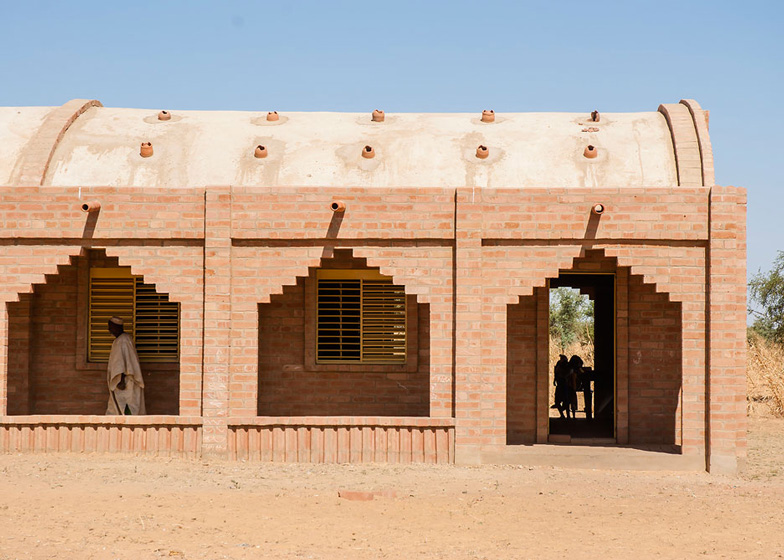Dutch firm Levs Architecten used unfired clay bricks from local mines to build the barrel-vaulted structure of this primary school on one of Mali's vast plains (+ slideshow).
Located in Tanouan Ibi, a village within Mali's Dogon region, the school complex is made up of several blocks but the main teaching areas are located in one single-storey classroom building.
Levs Architecten positioned three identically sized classrooms in a row along the central axis of this building, then added a pair of sheltered verandas to the two long sides to provide spaces where students can sit down between classes.
"The verandas, equipped with small stone benches, offer pleasant exterior room to the students," said the architects.
The arched roof structures of these arcades also function as buttresses, supporting the weight of the main vault running along the building's centre.
The architects enlisted students from a nearby university and members of the local community to help construct the building, using the compressed clay bricks to build walls, floors and roofing.
"The use of these blocks of compressed earth leads to a supple integration into the environment, corresponding to the way almost all Dogon villages fit into the landscape," they said.
Ceramic pipes puncture the roof of the building, bringing light and ventilation into the classrooms. These can be blocked up during the two-month-long rainy season, during which time a waterproof layer of clay mixed with cement prevents ceilings from leaking.
Each classroom accommodates up to 60 students and there's also an office and storage closet. Doors and window shutters are painted pale yellow to complement the red tones of the clay.
Here's a project description from Lev Architecten:
Primary School Tanouan Ibi
The village of Tanouan Ibi is situated on the plain, one hour driving from the main village Koundou in Dogon country, next to the rockface of Bandiagara in Mali (World Cultural Heritage of Humanity, Unesco 1986).
The ensemble is composed of different buildings. The first block is a school of three classes with two verandas and a curved roof. Next to this the installation of the sanitary block is arranged. The enclosure and the planting of trees will follow afterwards. The school is complying with the demands imposed by the government and by the CAP (Centre d'Animation Pédagogique). A classroom has a surface of 7 x 9 m² and offers space to about 60 students. In total the school delivers space to minimally 180 students (3 classrooms) and an office with storage facilities for the director.
The architecture of the school building is a search for a connection with the local traditions of building, of culture and of architecture. Through the use of a newly developed hydraulic-compressed earth block, the building withstands the climate of both hot sunlight and heavy rainfall. The stones are produced on the spot from locally mined clay. Processed in vaults, they provide an optimal cooling climate. The search for connection also implies seeking an expression joining itself to an architecture applying partitions of surfaces, openings and closures, windows and door frames and decorative forms. The use of these blocks of compressed earth, leads to a supple integration into the environment, corresponding to the way almost all Dogon villages fit into the landscape. The language of forms is a clear consequence of functional requirements.
The structure of the school building is unique with two verandas running parallel to the class rooms. The two verandas operate like buttresses to be able to capture the weight of the barrel vaults in the roofs over the classrooms. Next to this, the verandas, equipped with small stone benches, offer pleasant exterior room to the students. The verandas have been built in strokes of blocks of compressed earth. At the entries the blocks follow the tension lines of the arcs, which lead to characteristic openings. The roof and the eaves have been accentuated by an additional layer of stones and by dilatation stones, separating the barrel vaults.
The roof has been covered by a thick layer of 20-30 mm of red earth, mixed with cement in order to achieve a water proof and water resistant layer. The gargoyles, manufactured by the local people named Bozo, guarantee the swift drainage of rainwater. In the roof, custom-made ceramic tubes have been inserted, providingventilation for a pleasant inside climate and allowing daylight through the roof, like a starry sky. During the rainy season (2 months), taking place out of the school period, these tubes can be closed.
The openings in the facades, with their window frames and with blinds, are painted in a fresh and yellow colour. The floor stones have been laid down in a decorative pattern.
Project: Primary School
Architects: LEVS architecten, Amsterdam
Client: Foundation Dogon Education, Amsterdam
Contractor: Enterprise Dara, Sevaré, Mopti and executor Amayoko Tagadiou, in collaboration with students of the Lycée Technique in Sevaré and with the local population of Tanouan Ibi.
Commission: 2012
Construction: March – July 2013
Occupancy: October 2013
Site: 2.5 ha
Gross Floor: 200 m2
Costs: 45.000 Euro




